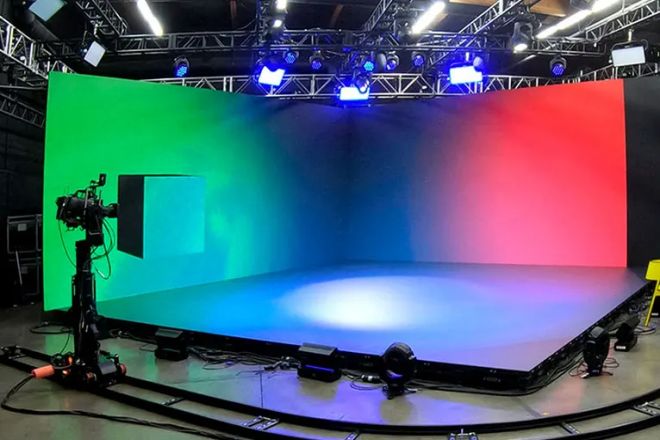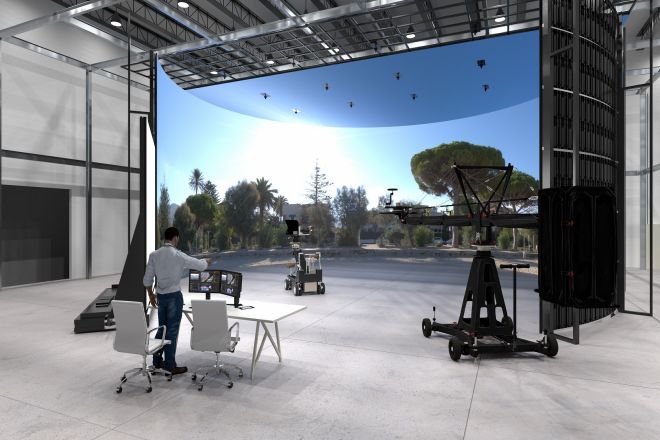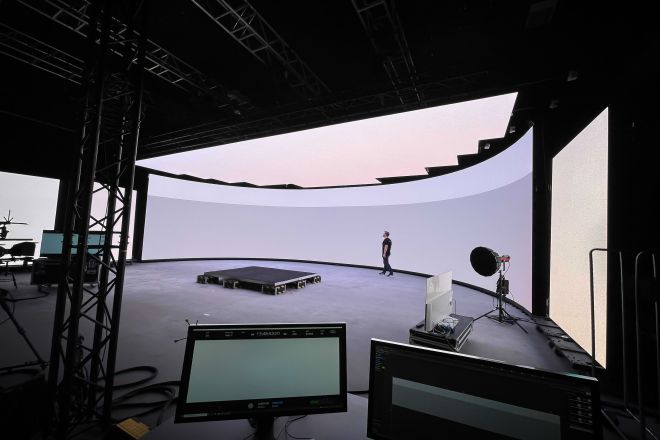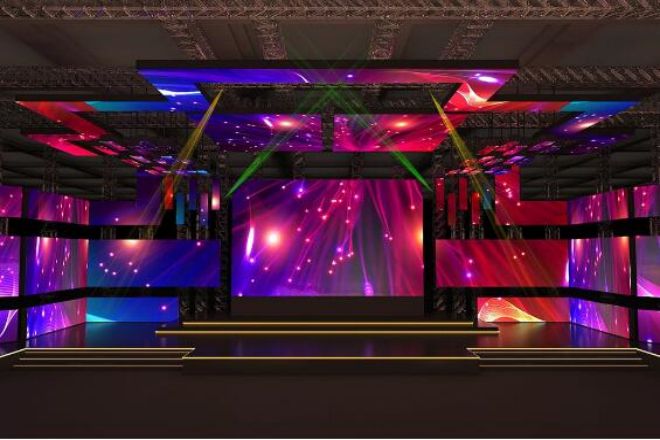Introduction

The virtual exclusive stage is the perfect combination of LED display technology and stage art. It breaks the limitations of the traditional stage and brings unprecedented possibilities to performances.
The virtual exclusive stage uses a combination of LED display and virtual reality technology to create an exclusive virtual space for performances. In this space, the stage design can be customized according to the performance theme and style, achieving perfect integration with the performance content.
At the same time, the audience can also participate in the performance through the LED display and interact with the stage in real-time, enhancing the audience’s sense of participation and immersion.
1. How do you use an LED display to create a virtual exclusive stage experience?

The use of LED displays to create a virtual and exclusive stage experience is an outstanding achievement of the combination of stage art and modern technology.
This innovative approach not only makes the stage design more diversified and personalized but also brings an unprecedented immersive experience to the audience. The following will explain in detail how to use LED displays to create such an experience while maintaining the professionalism and legibility of the content.
- Precise positioning of stage theme and content
First of all, it is necessary to clarify the theme, style, emotion, or information of the stage. This determines the selection and presentation of LED display content.
For example, if the stage theme is about natural ecology, then the display content can show natural landscapes such as forests, oceans, mountains, and rivers, bringing the audience into a natural world through high-definition picture quality and delicate color transitions.
- Customization and layout of LED display screen
According to the size and shape of the stage, an LED display screen of appropriate size and resolution can be customized. At the same time, the installation position and angle of the display screen should be taken into consideration to ensure that the audience can get the best visual effect no matter which angle they look at.
In terms of layout, multiple displays can be spliced together to create an enveloping or wrap-around stage effect to further enhance the sense of immersion.
- Deep integration of content and display
Content is at the heart of the virtual exclusive stage experience. The content of the LED display needs to be closely integrated with stage performance, sound effects, lighting, and other elements to form a whole.
For example, during a dance performance, the display screen can display background images related to the dance theme, which change with the rhythm and movements of the dance, creating a dynamic and interactive stage atmosphere.
- Real-time interaction and audience participation
Using LED displays to achieve real-time interaction between the audience and the stage is the key to improving the virtual exclusive stage experience. Interactive links can be set up to allow viewers to participate in voting, games, etc., through mobile phones or other devices, and the results will be displayed on display in real-time.
This interaction not only increases the audience’s sense of participation and immersion but also makes the stage performance more lively and interesting.
- The perfect combination of technology and art
When creating a virtual dedicated stage, technology and art need to be perfectly integrated. Technology provides the possibility and means of realization, while art gives life and soul to these contents.
Therefore, in the design process, it is necessary to constantly trial and error and adjust to find the balance between technology and art so that the two can promote and complement each other.
- Later maintenance and updates
The experience of a virtual exclusive stage is not achieved overnight; it requires continuous maintenance and updates. As technology and audience needs change, LED displays need to be calibrated, repaired, and updated regularly to ensure they remain in optimal condition.
2. What are the advantages of using LED displays for virtual staging compared to traditional setups?
Compared with traditional stages, using LED displays for virtual stage construction and display has many significant advantages. Here’s a detailed breakdown of these benefits:
- Rich and realistic visual effects:
With its high resolution and wide color gamut technology, LED displays can present detailed and realistic images and video content. This enables the virtual stage to display more colorful visual effects and bring a more shocking viewing experience to the audience.
- Flexible stage design:
The LED display can be customized according to different performance themes and needs, enabling rapid switching and changes in the stage background. This flexibility allows the virtual stage to easily adapt to various types of performances, bringing a new visual experience to the audience.
- Enhanced sense of space and layering:
Through clever LED display layout and content design, a more three-dimensional sense of stage space can be created. The audience seems to be in a multi-dimensional virtual world, feeling richer spatial levels and depths.
- Real-time interaction and sense of participation:
The LED display screen can interact with the audience in real time and enhance the audience’s sense of participation and immersion by displaying audience voting results, real-time comments, etc. This interaction not only enhances the audience’s viewing experience but also increases the fun and appeal of the performance.
- Energy saving, environmental protection, and cost-effectiveness:
LED display screens have a high energy efficiency ratio and can significantly reduce energy consumption compared with traditional stage lighting and scenery. At the same time, due to the durability and long life of LED displays, maintenance and replacement costs are also reduced, improving cost-effectiveness.
3. How can LED displays enhance the audience's virtual experience of exclusive stage events?

Through a series of technical means and design strategies, LED displays can significantly enhance the audience’s virtual experience of exclusive stage events. Here are some key ways:
First of all, high-definition picture quality and realistic colors are key. With its high definition and wide color gamut technology, the LED display screen presents delicate and realistic images and video content, giving the audience an immersive experience.
Whether it is the gorgeous stage background or the delicate characters, they can be perfectly displayed through the LED display, making the audience feel as if they are in a real virtual world.
Secondly, dynamic content and real-time interaction provide viewers with a more immersive experience. The LED display screen can update and change the content in real time according to the progress and needs of the stage activities, forming a close interaction with the actors’ performances, sound effects, lighting, and other elements.
For example, during a dance performance, the display can show a dynamic background that matches the dance rhythm, creating an immersive atmosphere. At the same time, the audience can also interact with the display screen through mobile phones or other devices and participate in voting, games, etc. This real-time interactivity further shortens the distance between the audience and the stage.
Furthermore, personalized customization and creative content are also important means for LED displays to enhance the virtual experience. LED displays can present different visual effects and content forms according to different stage themes and styles. Designers can transport viewers into a virtual world full of creativity and imagination through carefully crafted content.
This kind of personalized customization not only enhances the artistic expression of the stage but also brings a unique viewing experience to the audience.
In addition, multi-screen linkage and three-dimensional presentation also bring richer visual enjoyment to the audience. Through the splicing and linkage of multiple LED displays, a more three-dimensional and multi-level stage effect can be created.
This multi-screen linkage not only expands the display space of the stage but also provides the audience with a broader field of vision and more shocking visual effects.
Finally, the cooperation of sound effects and lighting is also an indispensable part of improving the virtual experience. The sound effects are coordinated with the content of the LED display to create a suitable atmosphere and mood, while the lighting can be used in conjunction with the display to create a more dazzling stage effect.
This all-around sensory stimulation allows the audience to be more deeply immersed in the world of the virtual stage.
4. What factors need to be considered for LED display virtual stage lighting and sound integration?
The lighting and sound integration of the LED display virtual stage is a comprehensive task, and multiple factors need to be considered to ensure that the final stage effect meets expectations. Here are some key factors:
1). Characteristics and configuration of LED display screen
Display effect: The resolution, color reproduction, contrast, and other characteristics of the LED display directly affect the visual effect of the virtual stage. It is necessary to choose the appropriate display type according to the theme and style of the stage to ensure clear images and bright colors.
Size and layout: The size and layout of the display need to be customized to the size and shape of the stage to ensure that the audience gets the best visuals, no matter where they are.
1). Lighting system
Lighting effects: Lighting plays a vital role in creating the stage atmosphere and highlighting the key points of the performance. It is necessary to choose the appropriate lighting type (such as follow lights, wash lights, etc.) and layout method according to the needs of the stage performance.
Lighting control: Through the intelligent lighting control system, precise control of lighting, including brightness, color, direction, etc., can be achieved, thereby creating a richer and more diverse stage effect.
3). Sound system
Sound effects: The sound system needs to ensure the clarity and restoration of the sound so that the audience can truly feel the performer’s voice and emotions.
Sound layout: Through reasonable sound layout and debugging, you can ensure the even distribution of sound on the stage and avoid problems such as sound dead spots or echo.
4). Integration and coordination
System integration: LED display screens, lighting systems, and sound systems need to be seamlessly integrated to ensure that the various systems work together and avoid problems such as signal interference or delay.
Effect coordination: In the design of the virtual stage, it is necessary to ensure the coordination and unity between the content of the LED display, lighting effects, and sound effects to create the best overall effect.
5). Security and Reliability
Equipment selection: When selecting LED displays, lighting, and audio equipment, you need to ensure that they comply with relevant safety standards and regulations to avoid safety accidents caused by equipment problems.
Backup and emergency response: In order to prevent equipment failure or unexpected situations from affecting the performance, it is necessary to prepare corresponding backup equipment and emergency plans to ensure the smooth progress of the performance.
5. What are the potential challenges or limitations of using LED displays for virtual exclusive staging? How to solve it?

Using LED displays for virtual exclusive stages can indeed bring stunning visual effects and immersive experiences. However, in practical applications, it also faces some potential challenges and limitations.
First of all, cost is an important factor to consider when using LED displays for virtual stage construction. The production, installation, and maintenance of LED displays require a large investment, which can be a huge challenge for some projects with limited budgets.
In order to solve this problem, we can choose to appropriately reduce the specifications and requirements of the display screen or reduce costs by optimizing the design and production process. At the same time, renting LED display screens is also a feasible option, as it can achieve high-quality stage effects without increasing long-term burden.
Secondly, technical limitations are also issues that need to be addressed when using LED displays. Although LED displays have made significant technological progress, there are still certain limitations in resolution, color expression, and viewing angles.
These restrictions may affect the audience’s viewing experience and reduce the quality of the stage effects. In order to overcome these technical limitations, we can choose more advanced LED display technology or maximize the performance of the display through reasonable use and adjustment.
At the same time, regular maintenance and calibration of the display screen are also important measures to maintain its good working condition.
In addition, content production is also an aspect that needs to be considered when using LED displays for virtual stages. The content of the virtual stage needs to match the characteristics of the LED display in order to present the best effect.
However, producing high-quality content requires the support of professional visual designers and content production teams, which may be a problem for some people who do not have relevant professional capabilities. In order to solve this problem, we can cooperate with a professional team or improve our design capabilities through learning and training.
At the same time, using professional video editing and special effects software can also improve the efficiency and quality of content production.
In addition, installation and debugging are also aspects that need to be paid attention to when using LED displays. The installation and debugging of LED displays require professional technology and experience, and the operation is complex and requires precise control. Improper installation and debugging may result in poor display or even malfunction.
In order to ensure the normal operation of the display screen, we can choose to hire a professional installation and debugging team to be responsible for this work. They have rich experience and professional skills to ensure the stability and safety of the display.
At the same time, it is also very important to make a detailed installation and commissioning plan, which can help us foresee and solve problems in advance and ensure the smooth progress of the performance.
Finally, environmental adaptability is also a factor to consider. The performance of LED displays may vary under different environmental conditions, and factors such as light and temperature may affect the display effect. Therefore, when choosing an LED display, we need to consider the actual conditions of the performance venue and choose a more adaptable display.
At the same time, it is also necessary to make appropriate adjustments and optimizations according to environmental changes to ensure that the display can present the best results in various environments.
Conclusion
In summary, LED display plays a decisive role in creating a virtual exclusive stage. With its unique technical advantages, it promotes the innovation and development of stage art.
If you want to know more about LED displays, please get in touch with us.
